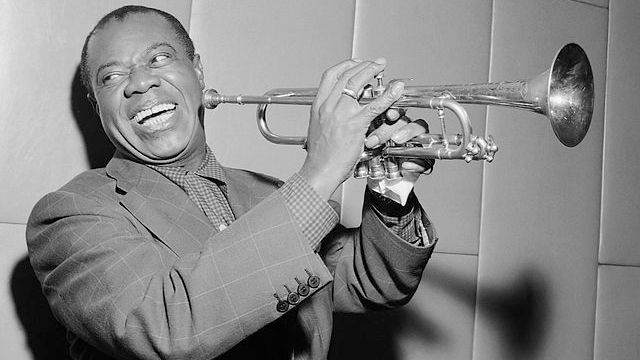|
There’s a heady echelon of artists who didn’t just excel at what they did, the very fact of their doing it changes the landscape of their craft. Louis Armstrong is, to borrow a phrase, in that number. From his first musical outings in ragtag bands at the Waif's Home for delinquents in New Orleans (where he became band leader at 13 years old) to a global presence that few musicians attain, Armstrong lead an extraordinary life.
Louis Armstrong’s Black & Blues, by director Sacha Jenkins, leans on a wealth of impressive source material (including the vast library of Armstrong’s uncensored home tapes) to create a structurally jazz-like film that paints an unflinching picture of a musical titan. His somewhat known rise from poverty, playing in the red light district of New Orleans’ Storyville, is fleshed out with some remarkable tales and film footage. The stories of his influence come thick and fast - he created scatting, his pivotal innovations injecting African rhythms into Western music, his pioneering of improvisational techniques…what we’re describing is virtually the invention of a genre. To quote virtuoso saxophonist Artie Shaw, “I would say jazz almost stems from Louis Armstrong.” Armstrong smashed through barriers as a force of nature. He was the first black artist to open a club, and a ballroom, and a radio station, and the the first black actor to have his name above the title in movie promotion. There are way too many anecdotes and insights to summarize here. The documentary packs them in, though, via talking heads, voiceovers by musical legends and extracts from Armstrongs’ letters and private archives. If you’re reading this you likely have a relationship with New Orleans. Louis Armstrong had one too, and it was…complicated. He left the city as a young man, following his musical heroes to Chicago and then to New York as his star ascended. His returns here were a mix of joy and stark reminders of Southern prejudice. We hear about his taking a private train to travel here, selling out a large theater, but the announcer of that theater refusing to bring him up on stage, using the most offensive slurs imaginable. The then mayor gave him the keys to the city, but in reality those keys could not unlock swathes of white-only spaces. White supremacy might performatively make token concessions, but it does not relent in its persecution. Armstrong’s civil rights stances are, of course, examined. He was often mocked by other black artists for playing a submissive role in the media, but like Sammy Davis Jr, this was a stealth offensive. Decades before Hendricks at Woodstock, Louis Armstrong would play the Star Spangled Banner as a political statement, he was in rooms that many other black people could not dream of entering, he was working to survive and elevate others from his position. There’s an incredible story by black actor Ossie Davis, who had “malice and ridicule” for Armstrong until he worked with him on a movie set and saw a steely melancholy in him. “Beneath that gravel voice and that shuffle,” he says, “Under all that mouth with more teeth than a piano had keys, was a horn that could kill a man.” New Orleans’ own Wynton Marsalis is one of the main commentators. He too came from a position of cynicism about Armstrong. It was all “Dixie and shufflin’,” he says. “In my time I hated that with unbelievable passion.” When Marsalis moved away from New Orleans, his father sent him tapes of Armstrong and said, “Why don’t you learn one of these solos?” After trying and failing to match the sonic range, the power of the musical register and the sheer endurance of Armstrong’s trumpet playing, Marsalis conceded his genius. Sacha Jenkins covers huge tracts of biographical ground. We get Armstrong the global megastar, playing to tribespeople in Ghana and in front of the pyramids in Egypt, Armstrong the marijuana and laxatives proponent, the avuncular chat show guest, the four wives, the uncompromising artist, the sweary rants at astonishing racism from low-level media personnel. Armstrong is criticized for not marching, but he buys coal for poor residents of cities he plays in, and he gives generously, working a different line of attack. In a lot of the footage, though, he is just spreading industrial amounts of joy. That famous, infectious grin, as big as a sunrise. As one commentator remarks, “It was not a simple-minded happiness, it was a transcendent joy.” That transcendence - social, musical, cultural, - is the feeling that you walk away with. Welcome to Armstrong’s complex, but wonderful world. (PO) Louis Armstrong's Black and Blues is playing at the Prytania Canal Place Comments are closed.
|
NEWSPreviews, reviews, offers and news in New Orleans. Categories
All
Archives
July 2024
|

 RSS Feed
RSS Feed